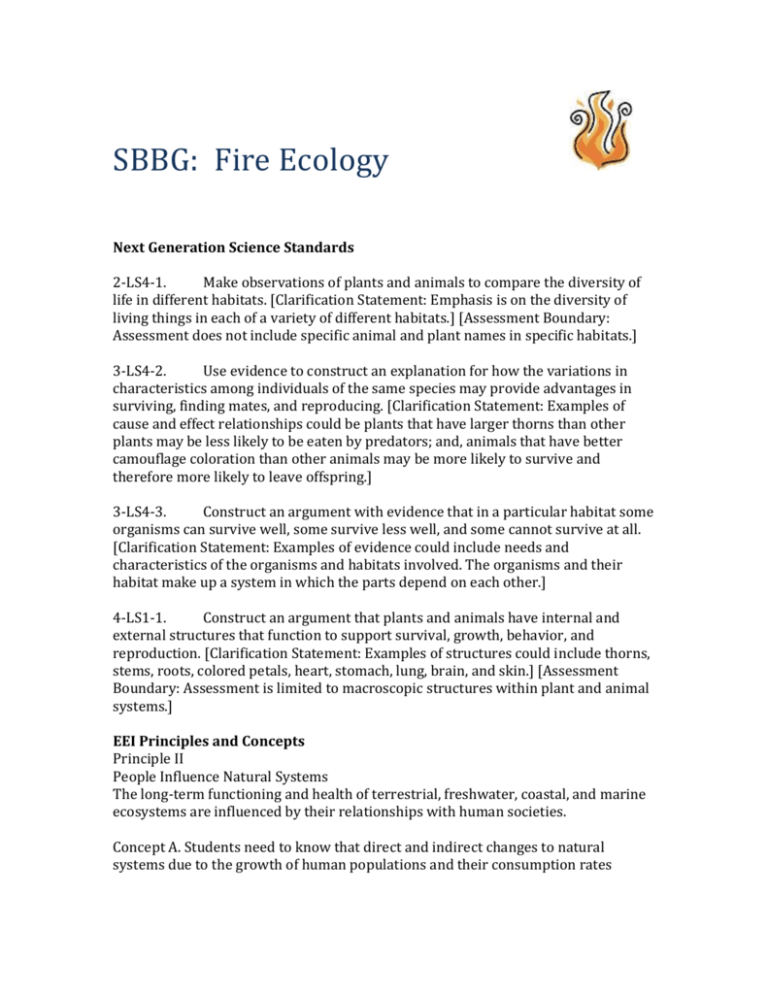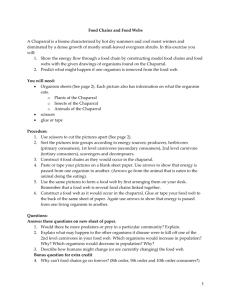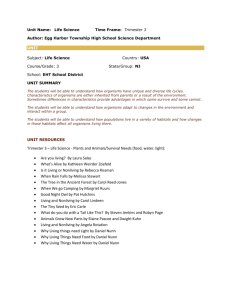Lesson Plan: Fire Ecology
advertisement

SBBG: Fire Ecology Next Generation Science Standards 2-LS4-1. Make observations of plants and animals to compare the diversity of life in different habitats. [Clarification Statement: Emphasis is on the diversity of living things in each of a variety of different habitats.] [Assessment Boundary: Assessment does not include specific animal and plant names in specific habitats.] 3-LS4-2. Use evidence to construct an explanation for how the variations in characteristics among individuals of the same species may provide advantages in surviving, finding mates, and reproducing. [Clarification Statement: Examples of cause and effect relationships could be plants that have larger thorns than other plants may be less likely to be eaten by predators; and, animals that have better camouflage coloration than other animals may be more likely to survive and therefore more likely to leave offspring.] 3-LS4-3. Construct an argument with evidence that in a particular habitat some organisms can survive well, some survive less well, and some cannot survive at all. [Clarification Statement: Examples of evidence could include needs and characteristics of the organisms and habitats involved. The organisms and their habitat make up a system in which the parts depend on each other.] 4-LS1-1. Construct an argument that plants and animals have internal and external structures that function to support survival, growth, behavior, and reproduction. [Clarification Statement: Examples of structures could include thorns, stems, roots, colored petals, heart, stomach, lung, brain, and skin.] [Assessment Boundary: Assessment is limited to macroscopic structures within plant and animal systems.] EEI Principles and Concepts Principle II People Influence Natural Systems The long-term functioning and health of terrestrial, freshwater, coastal, and marine ecosystems are influenced by their relationships with human societies. Concept A. Students need to know that direct and indirect changes to natural systems due to the growth of human populations and their consumption rates influence the geographic extent, composition, biological diversity, and viability of natural systems. Concept B. Students need to know that methods used to extract, harvest, transport, and consume natural resources influence the geographic extent, composition, biological diversity, and viability of natural systems. Concept C. Students need to know that the expansion and operation of human communities influences the geographic extent, composition, biological diversity, and viability of natural systems. Concept D. Students need to know that the legal, economic, and political systems that govern the use and management of natural systems directly influence the geographic extent, composition, biological diversity, and viability of natural systems. Principle III Natural Systems Change in Ways that People Benefit From and Can Influence Natural systems proceed through cycles that humans depend upon, benefit from, and can alter. Concept A. Students need to know that natural systems proceed through cycles and processes that are required for their functioning. Concept C. Students need to know that human practices can alter the cycles and processes that operate within natural systems. Lesson Plan: Fire Ecology Objective: Students will learn about the natural role that wildfire plays in the local ecology. Students will observe the different adaptations to fire that plants in the chaparral community have. Materials: KIN journal, fire ecology facts page, laminated photos of Jesusita fire Preparation: Locate the burned out Sycamore stump near the creek and a few other species (bays, toyons, etc.) with stumps nearby that have re-sprouted. Introduction: Ask students to look around and ask: What clues lead you to believe there may have been a fire here in the recent past? The Jesusita fire in 2009 is recent enough that some should remember the event. Though the garden has recovered quite well, there should still be some visible evidence. Many may have been evacuated from their homes. Ask: Is fire always a bad thing in nature? Why? Why not? Procedure: Discuss the role of fire in chaparral communities. Using the fire facts page, discuss the different adaptations that plants in a chaparral community have developed in order to cope with, and even rely on regular fire disturbances. Conclusion: Emphasize that fire suppression and prevention can negatively impact chaparral communities by increasing fire intensity. Many species of these plants rely on fire for re-generation and nutrient cycling. Suppressing fire increases the amount of dry material present in the community leading to more destructive fires. Emphasize that fire is considered to be a bad thing only because of human encroachment and the proximity of homes to areas prone to wildfire. Do the students think it is a smart thing for us to build houses so near to a plant community that requires fire in order to regenerate?











